Drake G.W.F. (editor) Handbook of Atomic, Molecular, and Optical Physics
Подождите немного. Документ загружается.

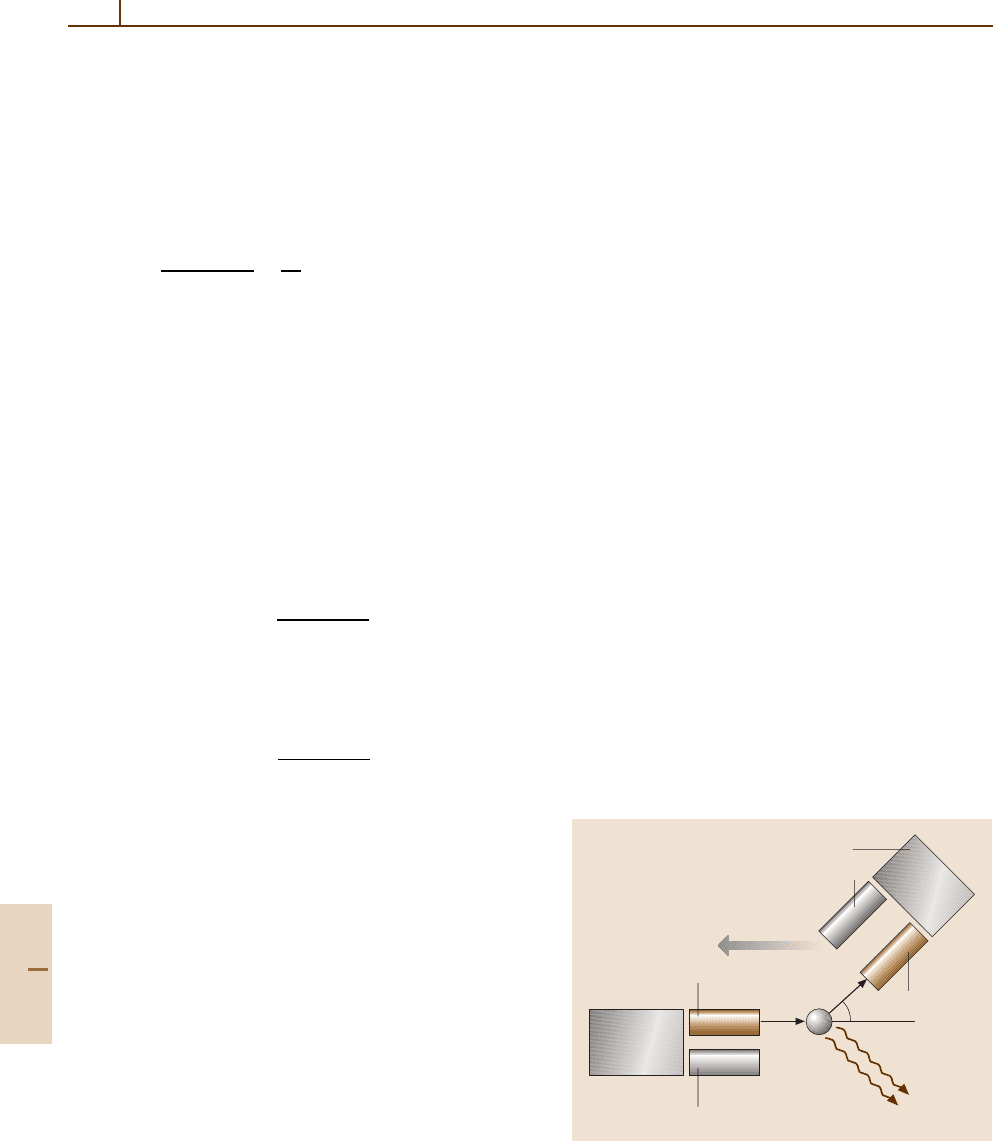
930 Part E Scattering Experiment
63.1.2 Definition of Cross Sections
The parameters which characterize collision processes
are the cross sections. Electron collision cross sections
depend on impact energy E
0
and scattering polar angles
θ and φ. The differential cross section, for a specific
well-defined excitation process indicated by the index n
is defined as
dσ
n
(E
0
,Ω)
dΩ
=
k
f
k
i
| f
n
(E
0
,Ω)|
2
, (63.1)
where Ω is the polar angle of detection, k
i
and k
f
are the initial and final electron momenta, and f
n
is
the complex scattering amplitude (n = 0 refers to elas-
tic scattering). Integration over the energy-loss profile
is assumed. If the energy-loss spectrum is broad, dif-
ferentiation with respect to energy loss also has to
be included. For certain processes it may be neces-
sary to define differential cross sections with respect
to angle and energy for both primary and secondary
particles.
Integration over all scattering angles yields the inte-
gral cross sections
σ
n
(E
0
) =
2π
0
π
0
dσ
n
(E
0
,Ω)
dΩ
sin θ dθ dφ.
(63.2)
In the case of elastic scattering, the momentum transfer
cross section is defined as
σ
M
0
(E
0
) =
2π
0
π
0
dσ
0
(E
0
,Ω)
dΩ
(1 − cos θ) sin θ dθ dφ.
(63.3)
The total electron scattering cross section is obtained by
summing all integral cross sections:
σ
tot
(E
0
) =
n
σ
n
(E
0
) +
m
σ
m
(E
0
), (63.4)
where σ
m
are the cross sections for other possible
channels. Experimental cross sections typically rep-
resent averages over indistinguishable processes (e.g.,
magnetic sublevels, hyperfine states, rotational states
etc.). The cross section obtained this way corresponds
to an average over initial and sum over final indis-
tinguishable states with equal weight given to the
initial states. (This may not always be true, as dis-
cussed later.) If the target molecules are randomly
oriented, the cross section averaged over these ori-
entations is independent of φ. In addition, there is
an averaging over the finite energy and angular res-
olution of the apparatus. It is important, therefore,
to specify clearly the nature of the measured cross
section, otherwise their utilization and comparison
with other experimental and theoretical cross sections
become meaningless. We denote the conventionally
measured differential and integral cross sections by
D
n
(E
0
,θ) and Q
n
(E
0
), with the various averagings
implied. Similarly, Q
M
(E
0
) and Q
tot
(E
0
) are the cor-
responding momentum transfer and total scattering cross
sections.
The collision strength for a process i → j,which
is the particle equivalent of the oscillator strength, is
defined by
Ω
ij
(E
0
) = q
i
E
0
σ
ij
(E
0
), (63.5)
where q
i
is the statistical weight of the initial state [q
i
=
(2L
i
+ 1)(2J
i
+ 1)], E
0
is in Rydbergs and σ
ij
is in units
of πa
2
0
.
The rate for a specific collision process (e.g., excita-
tion) for electrons of energy E
0
is given as
R
ij
(E
0
) = NI(E
0
)σ
ij
(E
0
), (63.6)
where N is the density of the target particles
m
−3
,
and I(E
0
) is the electron flux
m
−2
s
−1
; σ
ij
is in m
2
,
yielding R
ij
in units of m
−3
s
−1
. For nonmonoenergetic
electron beams, (63.6) must be integrated over E
0
to get
the average rate.
63.1.3 Scattering Measurements
Most scattering experiments, are carried out in a beam–
beam arrangement (Fig. 63.1). A beam of nearly
Energy
selector
Optics
Gun
Photons
Electrons
Ions
Detector
Signal
Energy analyzer
Optics
θ
Fig. 63.1 A schematic diagram for electron scattering
measurements
Part E 63.1
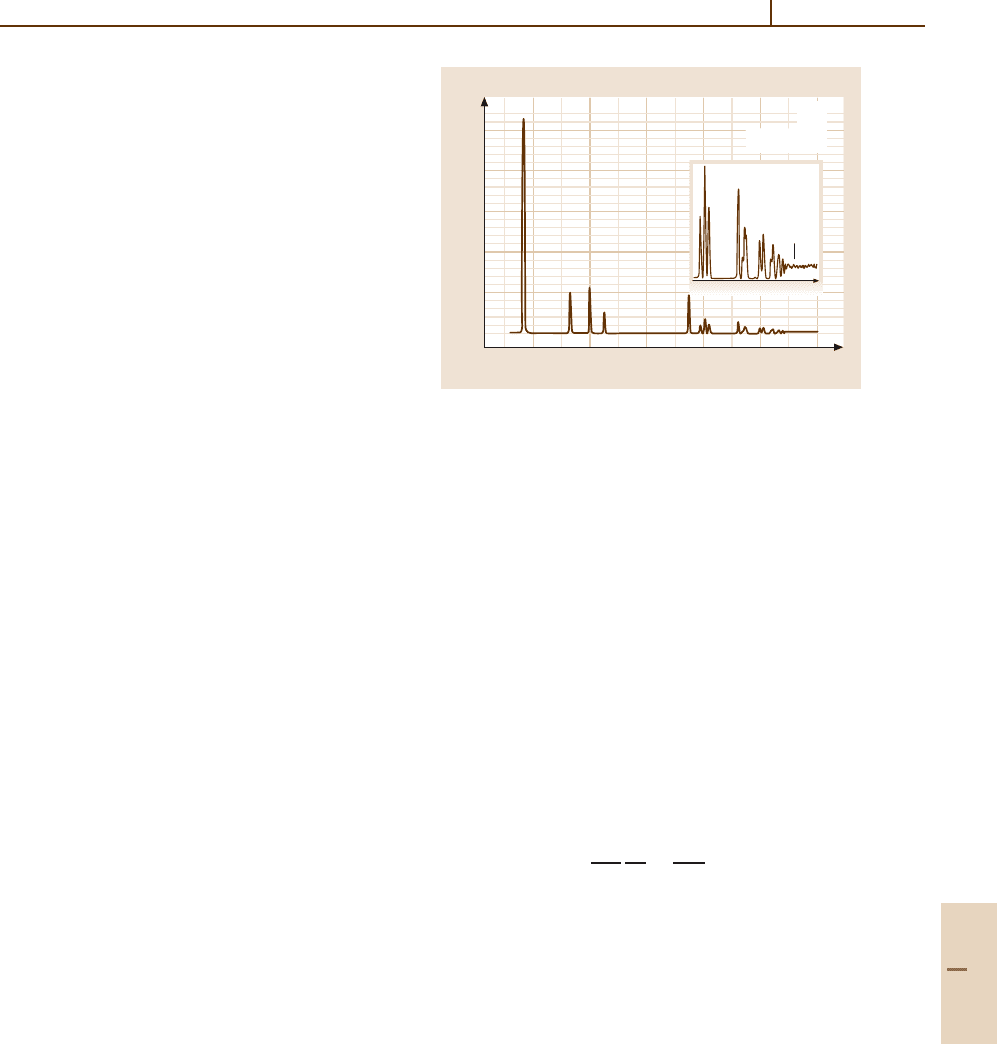
Electron–Atom and Electron–Molecule Collisions 63.1 Basic Concepts 931
monoenergetic electrons is formed by extracting elec-
trons from a hot filament and selecting a narrow segment
of the thermal energy distribution. For the formation
and control of the electron beam, electrostatic lenses
are used and the energy selection is achieved with
electrostatic energy selectors. A magnetic field may
also be applied to obtain a magnetically collimated
electron beam. The target beam is formed by let-
ting the sample gas effuse from an orifice, tube or
capillary array with various degrees of collimation.
Target species which are in the condensed phase at
room temperature need to be placed in a crucible and
evaporated by heating. Extensive discussion of this
technique has been given by Scoles [63.4]. The elec-
tron beam intersects the target beam at a 90
◦
angle
and electrons scattered into a specific direction, over
a small solid angle
≈ 10
−3
sr
, are detected. How-
ever the scattered electron is not necessarily the same
as the incoming electron. Exchange with the target elec-
trons may occur, and is required for spin-forbidden
transitions in light elements. The detector system con-
sists of electron lenses and energy analyzers similar
to those used in the electron gun. The actual detec-
tor is an electron multiplier which generates a pulse
for each electron. In the scattering process, secondary
species (electrons, photons, ions, neutral fragments)
may also be generated and can be detected individu-
ally or in various coincidence schemes. The experiments
are carried out in a vacuum chamber and it is im-
portant to minimize stray electric and magnetic fields.
More details about the apparatus and procedures can
be found in a review by Trajmar and Register [63.5].
The primary information gained in these experiments
is the energy and angular distribution of the scattered
electrons.
There are several methods used to carry out scat-
tering measurements. In the most commonly used
energy-loss mode, the impact energy and scattering an-
gle are fixed, and the scattering signal as a function of
energy lost by the electron is measured by applying pulse
counting and multichannel scaling techniques. The re-
sult of such an experiment is an energy-loss spectrum.
The elastic scattering feature appears at zero energy loss;
the other features correspond to various excitation pro-
cesses and to ionization. Energy-loss spectra can also
be generated in the constant residual energy mode. In
this case, the detector is set to detect only electrons with
a specific residual energy E
R
= E
0
− ∆ E at a fixed scat-
tering angle, and E
0
and ∆E are simultaneously varied.
Each feature in the energy-loss spectrum is obtained then
at the same energy above its own threshold. An exam-
250
200
150
100
50
0
20 21 22 23 24 25
c/s
Energy loss (eV)
He
90°
E
r
= 1.2 eV
4
5
6
IE
n = 2
3
×8
Fig. 63.2 Energy-loss spectrum of He at a constant residual
energy of 1.2 eV and scattering angle of 90
◦
. The inelastic
features with the corresponding principal quantum numbers
are shown. IE is the ionization potential of He (24.58 eV).
No background is subtracted and true signal zero is in-
dicated by a dotted line under the expand portion of the
spectrum m. (Taken from Allen [63.6])
ple, taken from the work of Allan [63.6], ist shown in
Fig. 63.2.
The energy loss spectrum becomes equivalent to the
photoabsorption spectrum in the limit of small momen-
tum transfer K,whereK = k
f
− k
i
(i. e., high impact
energy, small scattering angle). The equivalence of elec-
trons and photons in this limit follows from the Born
approximation, and it can be used to obtain optical
absorption and ionization cross sections. The correspon-
dence is defined through the Limit Theorem
lim
K→0
f
G
n
(K) = f
opt
n
, (63.7)
f
G
n
(K) =
∆E
2
k
i
k
f
K
2
dσ
n
dΩ
(k),
(63.8)
where f
G
n
is the generalized oscillator strength for
excitation process n,and f
opt
n
is the corresponding
optical f-value. Equation (63.7) was originally de-
rived by Bethe [63.7] from the Born cross section.
It was extended later by Lassettre et al. [63.8]to
cases where the Born approximation does not hold. In
this case, f
G
n
(K) is replaced by f
app
n
(K), the appar-
ent generalized oscillator strength. The Limit Theorem
implies that, in the limit of small K, optical selec-
tion rules apply to electron impact excitation. The
practical problem is that the limit is nonphysical and
the extrapolation to zero K involves some arbitrari-
ness. When K is significantly different from zero,
Part E 63.1
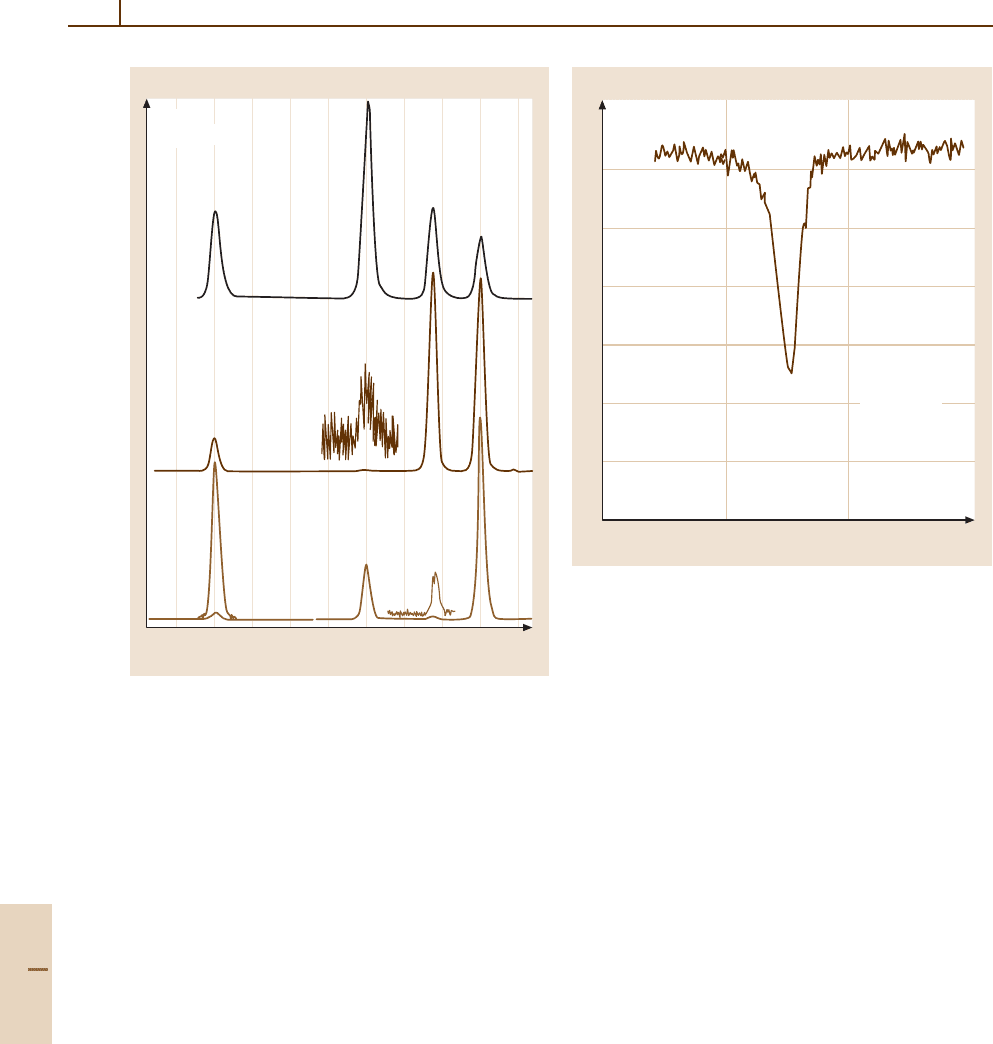
932 Part E Scattering Experiment
0.6 0.8 20 0.2 0.4 0.6 0.8 21 0.2 0.4
Intensity (arb. units)
Energy loss (eV)
He
E
0
= 40.1 eV
125°
50°
5°
×50
×20 ×20
Fig. 63.3 Variation of energy-loss spectra (and DCSs) with
scattering angle for He at 40 eV impact energy. Spectra are
shown at 5
◦
,50
◦
and 125
◦
scattering angles
optical-type selection rules do not apply to electron-
impact excitation. As can be seen from Fig. 63.3,spin
and/or symmetry forbidden transitions then readily oc-
cur and can be an efficient way of producing metastable
species.
Selection rules for electron impact excitations can
be derived from group theoretical arguments [63.9, 10].
For atoms, the selection rule S
g
↔ S
u
applies in gen-
eral and scattering to 0
◦
and 180
◦
is forbidden if
(L
i
+ Π
i
+ L
f
+ Π
f
) is odd. Here, L
i
and L
f
are the
angular momenta and Π
i
and Π
f
are the parities. For
molecules, selection rules can be derived under two
special conditions: (a) rules concerning 0
◦
and 180
◦
scattering for arbitrary orientation of the molecule, and
(b) rules concerning scattering to any angle but for spe-
cific orientation of the molecule. An important example
of the first case is the Σ
−
↔/Σ
+
selection rule for linear
molecules at 0
◦
and 180
◦
scattering angles.
6
4
2
0
19.2 19.3 19.4 19.5
E
0
(eV)
10
3
counts/ channel
He
θ = 90°
∆E = OeV
Fig. 63.4 The 19.37 eV He resonance observed in the elas-
ticchannelat90
◦
scattering angle
The energy dependence of cross sections is obtained
by fixing the energy-loss value (scattering channel) and
studying the variation of scattering signal with impact
energy at a given angle or integrated over all scatter-
ing angles. In general, cross sections associated with
spin forbidden and optically allowed transitions peak
near and at several times the threshold impact energy
respectively, and they usually vary smoothly with im-
pact energy. However, resonances may appear at certain
specific impact energies. These sudden changes are asso-
ciated with temporary electron capture and are the result
of quantum mechanical interference between two indis-
tinguishable paths. An example is shown in Fig. 63.4 for
He in the elastic channel at 19.37 eV impact energy.
Integral cross sections can be obtained from ex-
trapolation of the measured D
n
(E
0
,θ) to 0
◦
and 180
◦
scattering angles and integration over all angles. Re-
cently, incorporation of an “angle-changing” device has
enabled measurements to be extended over the whole
range of scatering angles [63.11, 12]. In certain cases it
is possible to measure integral cross sections directly by
detecting secondary products such as photons and ions.
These procedures and the resulting cross sections will
be discussed in some detail in Sect. 63.2.
Part E 63.1
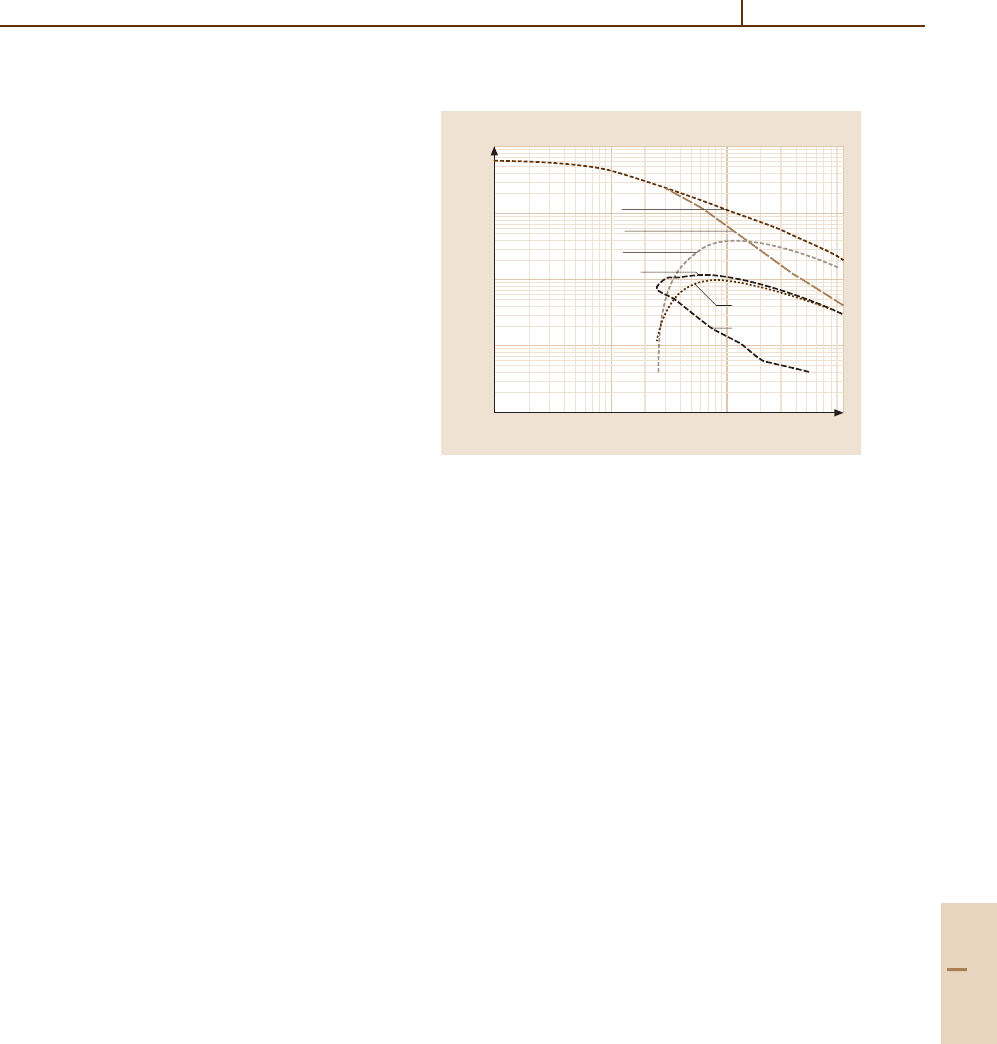
Electron–Atom and Electron–Molecule Collisions 63.2 Collision Processes 933
63.2 Collision Processes
In addition to the basic elastic and inelastic processes
defined in Sect. 63.1.2, we now also explicitly include
dissociation (to neutral and charged fragments) cross
sections Q
D
(E
0
); and ionization cross sections Q
I
(E
0
).
Each of these is now considered separately.
63.2.1 Total Scattering Cross Sections
Total electron scattering cross sections represent the sum
of all integral cross sections:
Q
tot
(E
0
) =
n
Q
n
(E
0
) + Q
I
(E
0
) + Q
D
(E
0
),
(63.9)
Q
tot
(E
0
) are useful for checking the validity of scat-
tering theories, and the consistency of available data,
for normalization of integral and differential cross sec-
tions, and as input to the Boltzmann equation. At low
impact energies, elastic scattering dominates, while at
intermediate and high impact energies, electronic ex-
citations and ionization become major contributors to
Q
tot
. Figure 63.5 shows the various cross sections for
electron–helium collisions. The data are from the rec-
ommended values of Trajmar and Kanik [63.13].
Two methods are commonly used for measuring
Q
tot
(E
0
): the transmission method and the target recoil
method (for details see [63.5,14]). Total scattering cross
sections measured by these techniques are, in general,
accurate to within a few percent. The extensive reviews
by Zecca and co-workers [63.15–17] should be noted.
63.2.2 Elastic Scattering Cross Sections
Elastic scattering cross sections Q
0
(E
0
) are not as
readily available as Q
tot
(E
0
). They are obtained from
differential scattering experiments over limited angular
ranges by extrapolation and integration of the measured
values. Typical error limits are 5 to 20%. For molecu-
lar species rotational excitation is usually not resolved
but is included in the D
0
(E
0
,θ) and Q
0
(E
0
) values.
In order to obtain the absolute D
0
(E
0
,θ) directly from
the scattering signal, one has to know the electron flux,
the number of scattering species, the scattering geom-
etry and the overall response function of the apparatus.
A direct measurement of these parameters can be made
at high energies (> 100 eV). However, at low electron
energies, this approach is not feasible. A number of
methods have been devised to derive relative D
0
(E
0
,θ)
from the measured scattering intensities and then to nor-
10
1
0.1
0.01
0.001
1 10 100 1000
Cross section (10
–16
cm
2
)
Energy (eV)
Helium
Q
o
Q
r
Q
l
Q
n =2
2
1
P
2
3
S+2
1
S
Fig. 63.5 Cross sections for various processes in the
electron–helium collision (see text for data sources)
malize the D
0
(E
0
,θ) to the absolute scale. We briefly
outline here only the most commonly used procedure.
The most practical and reliable method of obtain-
ing the absolute D
0
(E
0
,θ)is the relative flow technique
in which scattering signals for a known standard gas
and an unknown test gas are compared at each energy
and angle [63.5, 18–20]. The He elastic cross section is
the natural choice of standard since it is known accu-
rately over a wide energy and angular range, and He is
experimentally easy to handle. Only the relative elec-
tron beam flux and molecular beam densities (and their
distributions) need be known in the two measurements.
The flow rate of the test gas is adjusted so that the flux
and density distribution patterns of the two gases are
identical, and all geometrical factors cancel in the scat-
tering intensity ratios. The absolute D
0
(E
0
,θ) for the
sample gas is obtained from the measured scattering in-
tensity, target density, and electron beam intensity ratios
and the standard D
0
(E
0
,θ)value. See [63.5, 20, 21]for
a detailed discussion of this technique.
63.2.3 Momentum Transfer Cross Sections
Q
M
(E
0
) can be obtained both from the elastic DCSs
and from swarm measurements. At low electron-impact
energies (from 0.05 to a few eV), where only a few
collision channels are open, the electron swarm tech-
nique is the most accurate (≈ 3%) way to determine
the momentum transfer cross sections. Beam–beam ex-
periments are mandatory at higher energies. A detailed
Part E 63.2

934 Part E Scattering Experiment
discussion of these techniques is given by Trajmar and
Register [63.5].
63.2.4 Excitation Cross Sections
D
n
(E
0
,θ)and Q
n
(E
0
) can be derived from energy-loss
spectra obtained in beam–beam scattering experi-
ments. The relative D
n
(E
0
,θ) is usually normalized to
D
0
(E
0
,θ) which in turn is normalized to the helium
D
0
(E
0
,θ) by the relative flow technique described in
Sect. 63.2.2. There are, however, complications and un-
certainties associated with this technique because of the
sensitivity of the instrument response function to the
residual energy of the scattered electrons. For more de-
tails, see Trajmar and McConkey [63.21]. Data obtained
by this procedure are rather limited, partly due to experi-
mental difficulties and partly due to the time required to
carry out such measurements.
For cases where an excited state j is formed which
can radiatively decay by means of a short-lived (dipole-
allowed) transition to a lower lying state i, the intensity
of the resultant radiation is directly related to the cross
section for production of the excited state in the origin-
al collision process. An optical emission cross section,
Q
ji
(E
0
),isdefinedby
Q
ji
(E
0
) =
N
j
Γ
ji
In
0
τ
j
, (63.10)
where N
j
and n
0
are the densities in the excited and
ground states, respectively, Γ
ji
is the branching ratio for
radiative decay from state j to state i, I is the electron
beam flux, and τ
j
is the natural radiative lifetime of
state j. Since the excited state may be produced either
by direct electron impact or by cascade from higher-
lying states k, also formed in the collision process, we
may define the direct excitation cross section Q
d
j
(E
0
)
by
Q
d
j
(E
0
) =
i
Q
ji
(E
0
) −
k
Q
kj
(E
0
). (63.11)
The last term subtracts the cascade contribution from
higher lying states. The quantity Q
a
j
(E
0
) =
i
Q
ji
(E
0
)
is known as the apparent excitation cross section
for level j. Clearly, to obtain Q
d
j
(E
0
) from Q
a
j
(E
0
),
the cascade contribution must be known.
In (63.10), N
j
Γ
ji
/τ
j
gives the steady state number
of j → i photons per unit time per unit volume emitted
from the interaction region. Since observation is made
in a particular direction care must be taken to correct for
any anisotropy in the radiation pattern. Alternatively,
if observation is made at the so-called “magic” angle
(54
◦
44
) to the electron beam direction, the emission
intensity per unit solid angle is equal to the average inten-
sity per unit solid angle irrespective of the polarization of
the emitted radiation. However, even at this magic angle,
care must be taken to avoid problems with polarization
sensitivity of the detection equipment [63.22, 23].
The phenomenon of radiation trapping is often
a problem if the radiative decay channels of the excited
state include a dipole allowed channel to the ground
state. Repeated absorption and re-emission of the ra-
diation can occur and can lead to a diffuse emitting
region much larger than the original interaction region,
and the polarization of the emitted light can also be
altered. Often a study of the variation of the emitted
intensity or polarization with the target gas pressure is
sufficient to reveal the presence of radiation trapping or
other secondary effects.
The emission cross sections of certain lines have
been measured with great care and now serve as
bench-marks for other work. Examples of these are the
measurements of van Zyl et al. [63.24]onthen
1
Slevels
of He in the visible spectral region or the measurements
of the cross section for production of Lyman α from H
2
in
the VUV region (see [63.25] for a full discussion of this
including many references). Use of secondary standards
is particularly important when crossed-beam measure-
ments are being carried out because of the cancellation
of geometrical and other effects which occur.
The Bethe–Born theory [63.26] provides a conve-
nient calibration of the detection system for optically
allowed transitions of known oscillator strength. At suf-
ficiently high energies, the excitation cross section, Q
n
,
of level n is given by
Q
n
=
4πa
2
0
E
0
/R
∞
f
opt
n
∆E
n
/R
∞
ln(4c
n
E
0
/R
∞
). (63.12)
Here ∆ E
n
is the excitation energy, and c
n
is a constant
dependent on the transition. A plot of Q
n
E
0
versus ln E
0
is a straight line with a slope proportional to f
opt
n
and the
intercept with the ln E
0
axis yields an experimental value
for c
n
independent of the normalization. For example,
the He n
1
P–1
1
S optical oscillator strengths are very
accurately known, as are cascade contributions. Thus
accurate normalization of the slope of the Bethe plot can
be made, yielding accurate excitation cross sections.
As mentioned above, the excitation cross sections
display characteristic shapes as a function of energy.
For optically allowed transitions, the cross section rises
relatively slowly from threshold to a broad maximum ap-
proximately five times the threshold energy. At higher
energies the (ln E
0
)/E
0
dependence of the cross section
Part E 63.2

Electron–Atom and Electron–Molecule Collisions 63.2 Collision Processes 935
predicted by (63.12) is observed. For exchange pro-
cesses, e.g., a triplet excited state from a singlet ground
state, the cross section peaks sharply close to threshold
and falls off at high energy as E
−3
. If the excitation is
spin allowed but optically forbidden, e.g., He n
1
D from
1
1
S , then the Bethe theory predicts an E
−1
dependence
of the cross section at high energies.
When excitation occurs to a long-lived (metastable
or Rydberg) state following electron impact, it is often
possible to detect the excited particle directly. Time-
of-flight (T.O.F.) techniques are used to distinguish the
long lived species from other products, e.g., photons,
produced in the collisions.
63.2.5 Dissociation Cross Sections
Dissociation of a molecular target can result in frag-
ments which may be excited or ionized. Such processes
may be studied using the techniques discussed in the pre-
vious section or in the following section, where charged
particle detection is considered. Because a repulsive
state of the molecule is accessed, the fragments can
leave the interaction region with considerable kinetic
energy (several eV). If the fragment is in a long-lived
metastable or Rydberg state, T.O.F. techniques may be
used to distinguish the long-lived species from other
products such as photons, and also to measure the
energies of the excited fragments, and thus provide in-
formation on the repulsive states responsible for the
dissociation. For further discussion see the reviews by
Compton and Bardsley [63.27], Freund [63.28], and
Zipf [63.29]. If the detector can be made sensitive to
a particular excited species, its excitation can be iso-
lated and studied. Examples are the work of McConkey
and co-workers [63.30,31]onO(
1
S)andS(
1
S
0
) produc-
tion from various molecules. The detection of unexcited
neutral fragments is more challenging. One early method
was to trap selectively the dissociation products using
a getter and measure the resulting pressure decrease.
In a more sophisticated approach, Cosby [63.32]pro-
duced a fast (≈ 1 keV) target molecular beam by resonant
charge exchange and subjected it to electron impact dis-
sociation. The fast dissociation products were detected
by conventional particle detectors in a time correlated
measurement. Laser techniques, such as laser-induced
fluorescence or multiphoton ionization, have also been
used recently to detect the dissociation products.
The Franck–Condon principle largely governs mo-
lecular dissociation. The principle states that if the
excitation takes place on a time scale which is short
compared with vibrational motion of the atomic nu-
clei the transition occurs vertically between potential
energy curves. Since dissociation rapidly follows a ver-
tical transition to the repulsive part of a potential energy
curve, compared with the period of molecular rotation,
the dissociation products tend to move in the direction of
vibrational motion. Since the excitation probability de-
pends on the relative orientation of the electron beam and
the molecule, dissociation products often demonstrate
pronounced anisotropic angular distributions. The an-
gular distributions have been analyzed by Dunn [63.33]
using symmetry considerations.
63.2.6 Ionization Cross Sections
Tate and Smith [63.34] some 60 years ago developed
the basic techniques for measuring total ionization
cross sections. These were later improved by Rapp and
Englander-Golden [63.35]. Full details of the experi-
mental methods are given in the reviews and books
already cited. Märk and Dunn[63.36] reviewed the situ-
ation as it existed in the mid 1980s. In the basic “parallel
plate” method, the electron beam is directed through
a beam or a static target gas between collector plates
which detect the resultant ions. Unstable species can be
studied by the “fast neutral beam” technique [63.37],
in which the neutral target species is formed by charge
neutralization from a fast ion beam, and is subsequently
ionized by a crossed electron beam. For the determi-
nation of partial ionization cross sections specific to
a given ion species in a given ionization stage, mass
spectroscopic (quadrupole mass spectrometer, electro-
static or magnetic charged particle analyzer or time of
flight) methods are used. Fourier Transform Mass Spec-
trometry (FTMS) has also been used effectively to study
fragmentation with formation of both positive and neg-
ative ions. Reference [63.38] is a recent example of this.
Absolute total ionization cross sections have been meas-
ured for a large number of species with an accuracy
of better than 10%. Christophorou and colleagues have
presented helpful compilations of ionization and other
data of particular relevance to the plasma processing
industry, [63.39, and earlier references in this journal].
A large number of mechanisms can contribute to
the ionization of atoms and molecules by electron im-
pact. For targets with only a few atomic electrons,
the dominant process is single ionization of the outer
shell, with the resultant ion being left in its ground
state. The process is direct and is characterized by
large impact parameters b and small momentum trans-
fers. The cross section varies with incident electron
energy in a way very similar to the optically allowed
Part E 63.2
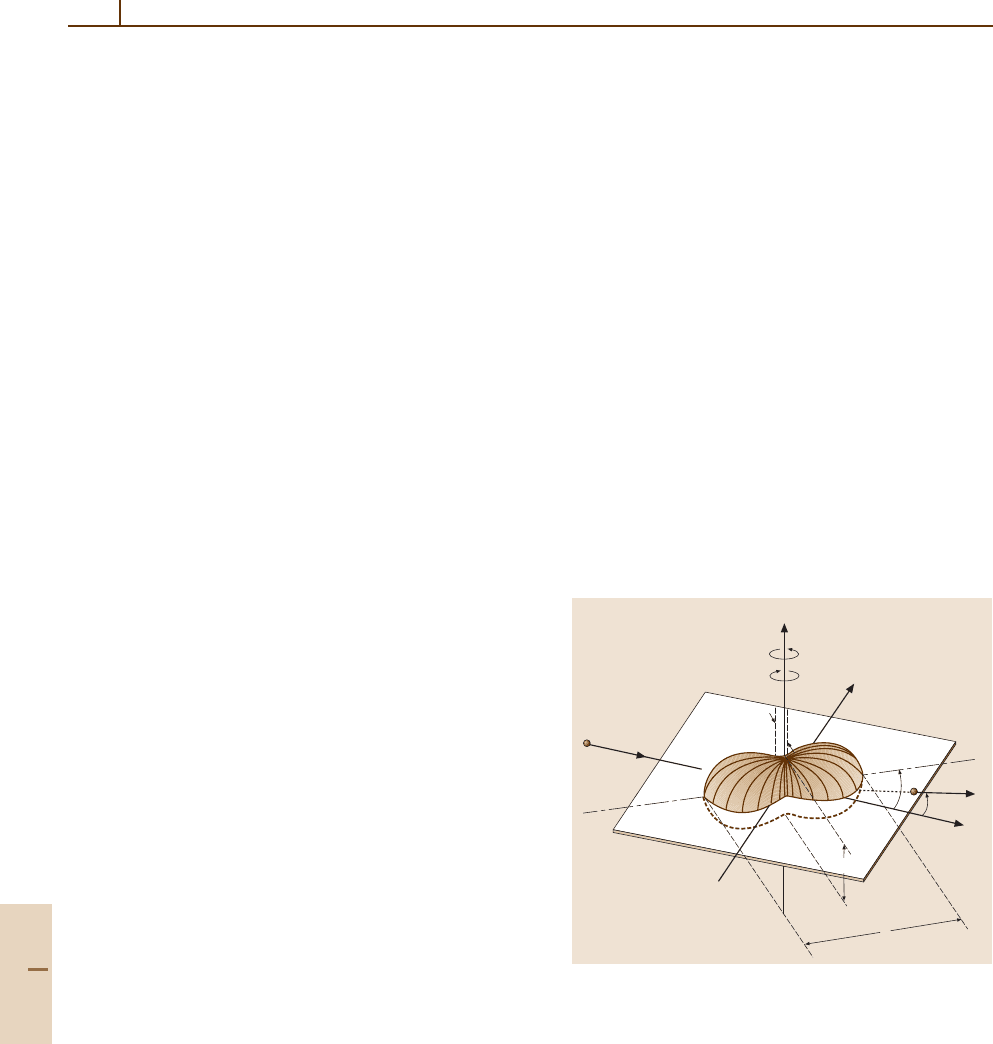
936 Part E Scattering Experiment
excitation processes discussed in Sect. 63.2.4. Processes
involving ionization of more than one outer shell elec-
tron become more important as the size of the target
increases. These events are associated with small b
and electron–electron correlations are usually strong.
Autoionization increases in significance for heavier tar-
gets. Here also, collisions with small b dominate and
electron–electron correlations are strong. For heavier
targets, inner shell effects, such as Auger electron or
X-ray emission, become progressively more important.
For molecular targets, dissociative ionization (either di-
rectly or through a highly excited intermediate state) and
ion pair formation also play a significant role.
In addition to measurement of gross ion production,
it is also possible to study the ionization process by
monitoring the electron(s) ejected or scattered inelas-
tically. Conventional electron spectroscopic techniques
are used for this purpose. The addition of coincidence
techniques (e–2e measurements) in which the momenta
of all the electrons involved are completely specified has
allowed many of the fine details of the ionization process
to be extracted [63.40].
63.3 Coincidence and Superelastic Measurements
The cross section measurements described so far do not
yield complete information on electron scattering pro-
cesses. As mentioned in Sect. 63.1.2, these cross sections
do not distinguish for magnetic sublevels, electron spin
etc.and represent summation of cross sections over these
experimentally indistinguishable processes (summation
of the square moduli of the corresponding scattering
amplitudes). The quantum mechanical description of
a scattering process is given in terms of scattering am-
plitudes and under certain conditions requires summing
up amplitudes and squaring the sum. This leads to inter-
ference terms which arise from the coherent nature of
the scattering process. A complete characterization of
a scattering process, therefore, requires knowledge of
the complex scattering amplitudes.
Sophisticated experimental techniques have been
developed in recent years, which go beyond the conven-
tional scattering cross section measurements and yield
information on magnetic sublevel specific scattering am-
plitudes and the polarization (alignment and orientation)
of the excited atomic ensemble. The experimental tech-
niques fall into two main categories: a) electron–photon
coincidence measurements, and b) superelastic scatter-
ing measurements involving coherently excited species.
(We still consider unpolarized electron beams in the
description of these two techniques here and will ad-
dress the question of spin polarization in the following
section.)
In electron–photon coincidence measurements, the
radiation pattern emitted by the excited atom is deter-
mined for a given direction of the scattered electron.
A scattering plane is defined by k
i
and k
f
, and hence
the symmetry is lowered from cylindrical (around the
incident beam direction) to planar, (Fig. 63.6).
It is now possible to determine, at least in principle,
both the atomic alignment (i. e., the shape of the excited
state charge cloud and its alignment in space) and its
orientation (i. e., the angular momentum transferred to
the atom during the course of the collision). Complete
sets of excitation amplitudes for the coherently excited
atomic states and their relative phases have been meas-
ured in some cases. A comparison with theory can then
be made at the most fundamental level. See [63.41]for
full discussion and analysis.
+
–
z
y
x
k
in
k
out
l
h
θ
col
γ
L
⊥
w
Fig. 63.6 Schematic illustration of a collisionally induced
charge cloud in a p-state atom. The scattering plane is fixed
by the direction of incoming k
in
and outgoing k
out
momen-
tum vectors of the electrons. The atom is characterized by
the relative length (l), width (w), and height (h)ofthe
charge cloud, by its alignment angle γ , and by its inherent
angular momentum L
⊥
. The coordinate frame is the nat-
ural frame with the z-axis perpendicular to the scattering
plane and with the x-andy-axesdefinedasshowninthe
figure relative to k
in
and k
out
Part E 63.3

Electron–Atom and Electron–Molecule Collisions 63.3 Coincidence and Superelastic Measurements 937
The electron–photon coincidence measurements can
be carried out in two ways: (1) measuring polarization
correlations, and (2) measuring angular correlations.
In (1), polarization analysis of the emitted photon in
a given direction occurs, while in (2), the angular
distribution of the emitted photons is determined with-
out polarization analysis. We will describe here only
method (1) in some detail.
Method (1) has the advantage that it measures di-
rectly the angular momentum (perpendicular to the
scattering plane) transferred in the collision. For P-state
excitation from a
1
S
0
ground state, four parameters
plus a cross section are needed to describe fully the
collisionally excited P-state. The natural parameters
introduced by Andersen et al. [63.41] are defined as fol-
lows (Fig. 63.6): γ is the alignment angle of the excited
state charge cloud relative to the electron beam axis,
P
+
is the linear polarization in the scattering plane,
L
+
⊥
is the orbital angular momentum perpendicular to
the scattering plane that is transferred to the atom in
the collision, and ρ
00
is the relative height of the charge
cloud perpendicular to the scattering plane at the point
of origin. The + superscript indicates positive reflection
symmetry with respect to the scattering plane.
In polarization correlation experiments, one typic-
ally measures two linear (P
1
, P
2
) and one circular (P
3
)
polarization correlation parameters perpendicular to the
scattering plane. One additional linear polarization cor-
relation parameter P
4
is measured in the scattering plane.
Each parameter is the result of two intensity meas-
urements for different orientations of the polarization
analyzer:
P
1
=
I(0
◦
) − I(90
◦
)
I(0
◦
) + I(90
◦
)
β
−1
,
P
2
=
I(45
◦
) − I(135
◦
)
I(45
◦
) + I(135
◦
)
β
−1
,
P
3
=
I
R
− I
L
I
R
+ I
L
β
−1
,
P
4
=
I(0
◦
) − I(90
◦
)
I(0
◦
) + I(90
◦
)
β
−1
. (63.13)
Here I(α) denotes the photon intensity measured for
a polarizer orientation α with respect to the electron
beam axis, I
R
and I
L
refer to right- and left-handed
circularly polarized light and β denotes the polarization
sensitivity of the polarization analyzer. The relationships
between the experimentally determined polarization cor-
relation parameters and the natural parameters are given
by
γ =
1
2
tan
−1
(P
2
/P
1
),
P
+
=
P
2
1
+ P
2
2
1/2
,
L
+
⊥
=−P
3
,
ρ
00
=
(1 + P
1
)(1 − P
4
)
4 − (1 − P
1
)(1 − P
4
)
.
(63.14)
The total polarization P
+
tot
, which is defined as
P
+
tot
=
P
+
2
+
L
+
⊥
2
1/2
=
P
2
1
+ P
2
2
+ P
2
3
1/2
, (63.15)
is a measure for the degree of coherence in the excitation
process. In the absence of atomic depolarizing effects
due to, for example, fine and/or hyperfine interactions,
a value of P
+
tot
=+1 for the emitted radiation indicates
total coherence of the excitation process.
Much of the earlier work involved excitation of he-
lium n
1
P state. Here the situation is simplified as L–S
coupling applies strictly: P
4
= 1andρ
00
is zero. Excita-
tion of the 2
1
P state, for example, is fully coherent and
hence the excitation is completely specified by just two
parameters, γ and L
⊥
or P
since P
=
1 − L
2
⊥
1/2
.
More recently, the techniques have been applied to
heavier targets and more complicated excitation pro-
cesses [63.42–46].
The superelastic scattering experiments could be
looked at as time inverse electron–photon coincidence
experiments (although this is not exactly the case). In
these experiments, a laser beam is utilized to prepare
a coherently excited, polarized ensemble of target atoms
for the electron scattering measurement. The superelas-
tic scattering intensity is then measured as a function
of laser-beam polarization and/or angle with respect to
a reference direction. Linearly polarized laser light pro-
duces an aligned target (uneven population in magnetic
sublevels for quantum numbers of different |M
J
| value).
Circularly polarized laser light produces oriented targets
(uneven population in M
J
=+m and M
J
=−m mag-
netic sublevels). From these measurements the same
electron impact coherence parameters can be deduced
as from the coincidence experiments. This approach has
been applied to atomic species (mainly metal atoms)
which are conveniently excited with available lasers.
Detailed descriptions of the experimental techniques,
the underlying theoretical background, and the interpre-
tation of the experimental data are given in [63.47–56].
It should be noted that electron scattering by co-
herently excited atoms can be utilized not only for
obtaining electron impact coherence parameters for in-
elastic processes originating from ground state but for
Part E 63.3

938 Part E Scattering Experiment
elastic, inelastic, and superelastic transitions involving
excited states. These measurements yield information on
creation, destruction, and transfer of alignment and ori-
entation in electron collision processes which is needed,
e.g., in the application of plasma polarization spec-
troscopy [63.57].
63.4 Experiments with Polarized Electrons
So far we have considered the utilization of unpolarized
electron beams which yield spin averaged cross sec-
tions. Little information on spin dependent interactions
is gained from these experiments. However, these inter-
actions can be studied using polarized electron beam
techniques. Developments on both the production and
detection of spin-polarized electron beams have resulted
in a wide range of elegant experiments probing these
effects. The theory is also highly developed. For a de-
tailed discussion see the works of Kessler [63.58, 59],
Blum and Kleinpoppen [63.60], Hanne [63.61–63]and
Andersen et al. [63.44, 45] and the references therein.
Some basic concepts are presented here.
ThedegreeofpolarizationP of an electron beam is
given by
P =
N(↑) − N(↓)
N(↑) + N(↓)
,
(63.16)
where N(↑) and N(↓) are the numbers of electrons with
spins respectively parallel and antiparallel to a particular
quantization direction. Measurements of P both before
and after the collision enable one to probe directly for
specific spin dependent processes. For example, in elas-
tic scattering from heavy spinless atoms any changes in
the polarization of the electrons must be caused by spin–
orbit interactions alone since, in this instance, it is not
possible to alter the polarization of the electron beam
by electron exchange. Measurements have been carried
out for Hg and Xe and both direct (f) and spin-flip (g)
scattering amplitudes, as well as their phase differences,
have been determined [63.59].
The spin–orbit interaction for the continuum elec-
tron caused by the target nucleus leads to different
scattering potentials and consequently to different cross
sections for spin-up and spin-down electrons (called
Mott scattering). Consequently, an initially unpolarized
electron beam can become spin polarized after scattering
by a specific angle according to
P
= S
p
(θ)
ˆ
n , (63.17)
where nis the unit vector normal to the scattering plane,
S
p
(θ) is the polarization function and P
is the polariza-
tion of the scattered beam. For the same reasons, when
a spin-polarized electron beam is scattered by an an-
gle θ to the left and to the right, an asymmetry is found
in the scattering cross sections. Furthermore, an existing
polarization P
can be detected through the left–right
asymmetry A in the differential cross section, which is
given by
A ≡
σ
l
(θ) − σ
r
(θ)
σ
l
(θ) + σ
r
(θ)
= S
A
(θ)P
·
ˆ
n , (63.18)
where σ
l
(θ) and σ
r
(θ) are the differential cross sec-
tions for scattering at an angle θ relative to the incident
beam axis to the left and to the right, respectively. For
elastic scattering, the polarization function S
P
,andthe
asymmetry function S
A
are identical and are called the
Sherman function.
When electron exchange is studied under conditions
where other explicitly spin-dependent forces can be ne-
glected, the cross sections for scattering of polarized
electrons from polarized atoms depend on the rela-
tive orientation of the polarization vectors. According
to [63.59]
σ(θ) = σ
u
(θ)[1 − A
ex
(θ)P
e
· P
A
] , (63.19)
where P
e
and P
A
are the electron and atom polarization
vectors, and σ
u
(θ) is the cross section for unpolarized
electrons. Hence, an “exchange asymmetry” A
ex
(θ) can
be defined by
A
ex
(θ) P
e
· P
A
=
σ
↑↓
(θ) − σ
↑↑
(θ)
σ
↑↓
(θ) + σ
↑↑
(θ)
,
(63.20)
where σ
↑↑
(θ) and σ
↑↓
(θ) denote the cross sections
for parallel and antiparallel polarization vectors respec-
tively. As Bartschat [63.64] points out, an asymmetry
can occur even if the scattering angle is not defined. In
this case the function A
ex
(θ) is averaged over all an-
gles. Differential and integral measurements of this kind
have been performed for elastic scattering, excitation
and ionization.
For heavy target systems it is necessary to consider
a combination of effects together with a description of
the target states in the intermediate or fully coupled
scheme. Consequently, the number of independent par-
ameters can become very large and the “complete”
experiments, which disentangle the various contribu-
tions to any observed asymmetry in the scattering, are
rarely possible.
Part E 63.4

Electron–Atom and Electron–Molecule Collisions 63.6 Electron Collisions in Traps 939
Even for very light target atoms, where conven-
tional Mott scattering is negligible, Hanne [63.61]has
shown that the “fine structure” effect, in which elec-
tron scattering from individual fine structure levels of
a multiplet occurs, can lead to polarization effects. In
fact it can be a dominating effect for inelastic collision
processes.
For full details of these various mechanisms and how
density matrix theory and other theoretical techniques
have been applied to scattering involving polarization
effects, the reader is referred to the review articles cited,
particularly Andersen et al. [63.44].
In certain cases, experiments involving spin po-
larized electron beams coupled with coincidence (or
superelastic) measurements allow one to extract the
maximum possible information for a given process, and
are termed as complete or perfect in the sense defined
by Bederson [63.65–67].
63.5 Electron Collisions with Excited Species
There are many plasma systems where electron colli-
sions with excited atoms and molecules play a prominent
role, e.g., electron beam and discharge pumped lasers,
planetary and astrophysical plasmas. Especially im-
portant are electron collisions with metastable species
because of the long lifetime, large cross section and large
amount of excitation energy associated with them. Elec-
tron collision studies and cross section data in this area
are scarce mainly due to experimental difficulties associ-
ated with the production of target beams with sufficiently
high densities of excited species. With the application
of lasers for the preparation of the excited species this
problem can be overcome. However, this approach has
not yet been extensively exploited. Reviews of this field
are given by Lin and Anderson [63.68], Trajmar and
Nickel [63.69]andChristophorou and Olthoff [63.70].
Since electron collisions with excited species nec-
essarily involve a method of preparation, they are two
step processes. Excitation and ionization in these cases
are frequently referred to as stepwise excitation and ion-
ization. The target preparation leads to mixed beams
containing both ground and excited atoms or molecules.
Preparation of excited atoms is achieved by electron im-
pact or photoabsorption. Fast metastable beams can be
produced by near-resonance charge exchange. For more
details see [63.69, 71, 72]. Electron impact excitation is
simple and effective but highly nonspecific, and charac-
terization of the composition of the mixture is difficult.
Laser excitation is more involved but very well defined.
Specific fine and hyperfine levels of individual isotopes
can be excited. When laser excitation is used in con-
junction with superelastic electron scattering, an energy
resolution of 10
−8
eV is easily achieved, compared with
the 10
−2
eV resolution possible in conventional electron
scattering.
Depending on the method of preparation, the popu-
lation distribution in the magnetic sublevels of the target
atoms may be uneven and some degree of polarization
(alignment or orientation) may be present. The scattering
will then be φ-dependent. For polarized target atoms the
measured electron collision cross sections do not cor-
respond to the conventional cross sections (which are
summed over final and averaged over initial experimen-
tally indistinguishable states, with equal populations in
the initial states). One, therefore, has to characterize pre-
cisely the state of the target beam in order to be able to
deduce a well defined, meaningful cross section. Polar-
ization of atoms can be conveniently controlled, in the
case of excitation with laser light, through the control of
the laser light polarization (as discussed in Sect. 63.3).
Since the atomic ensemble is coherently excited in this
case, the scattering cross sections will depend on the
azimuthal scattering angle φ. These considerations also
come into play when one tries to relate measured inelas-
tic and corresponding inverse superelastic cross sections
by the principle of detailed balancing.
63.6 Electron Collisions in Traps
A technique which has recently begun to be exploited
involves collisions with trapped atoms. Pioneered by
Lin and colleagues [63.73, 74], using Rb targets the
technique has many advantages over more conventional
techniques, not least of which is the fact that the absolute
number density of the target need not be known. Cross
section data are obtained from measurements of trap loss
and electron beam current density. Because up to half of
the atoms in the trap can be in the excited state, it is pos-
sible to make measurements of cross sections involving
excited states as well [63.75]. Measurements involving
Cs targets have also been reported [63.76].
Part E 63.6
